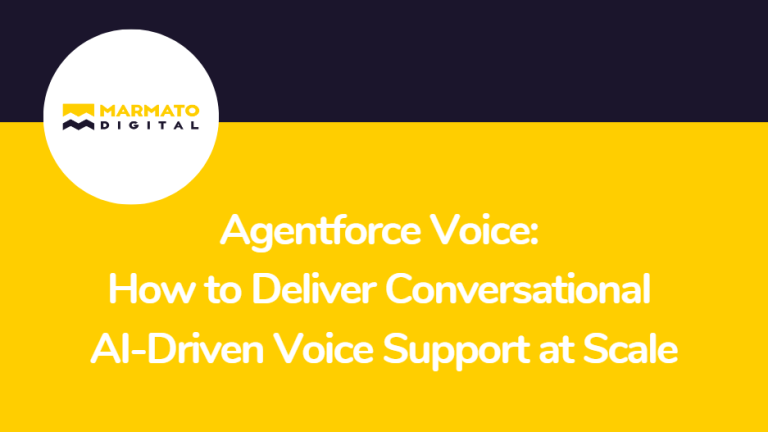Today’s customers expect fast, natural conversations when they call for support. While many organizations have focused on chat, messaging, or email channels, voice remains one of the most important touchpoints. With traditional phone systems and rigid IVRs, key context is lost, insights go unused, and customers often feel like they’re starting over every time.
That’s where Agentforce Voice enters. Built by Salesforce, Agentforce Voice brings AI-powered voice agents into the mix, enabling you to offer 24/7 voice interactions across phone, web, and mobile, anchored in your CRM data and business flows.

What is Agentforce Voice?
Agentforce Voice is an AI-enabled voice agent solution from Salesforce that allows you to build voice-enabled agents that handle real-time conversations across phone, web, and mobile, while being grounded in your CRM system.
Unlike rigid menu-based IVR (interactive voice response) systems, Agentforce Voice uses natural language processing (NLP), reasoned actions, and context to interact more naturally.
Because it is native to the Salesforce platform, your voice agents can use the same topics, data, actions, and deployment tools as your existing agents, giving you consistency, fewer tool switches, and faster deployment.
Why Voice Matters Now?
- Phone remains a key channel: Many support organizations still rely heavily on voice, yet the calls often sit in a silo outside the CRM.
- Lost context equals frustration: When each call starts without customer history or prior context, the experience suffers. Agentforce Voice aims to fix that.
- Voice meets AI + data: Voice interactions now can feed into your enterprise data, become searchable, connected, and actionable, turning a historic cost-center into a strategic advantage.
- Scalability needs: Many organizations cannot scale human agents for every call. AI voice agents help scale while maintaining quality.
Key Features of Agentforce Voice:
Here are several important capabilities:
- Unified Build Experience:
You build voice agents using the same low-code Agentforce Builder you already use. That means no separate toolchain just for voice; you design, test, and deploy voice agents alongside your other channels. - Salesforce-Native Voice Agents:
Voice-enabled agents are tightly integrated with your Salesforce data: the same topics, actions, and CRM records your text/chat agents use. This brings context, personalization, and connected workflows to voice. - Multi-Channel Deployment:
You deploy once and scale across phone, web (e.g., click-to-talk), and mobile app voice. Agentforce Voice allows you to engage wherever the customer chooses. - Conversations Grounded in CRM Data:
Voice agents access customer history, preferences, and past interactions, all held in your Salesforce CRM or connected systems. That lets the agent anticipate needs, reduce repeats, and personalise the interaction. - Ultra Low-Latency Interactions:
Agentforce Voice is built for voice-speed: real-time, natural conversations without awkward delays or “robotic” pauses. - From Talk to Action:
The voice agent does more than answer questions: it can update records, create cases, trigger workflows, or integrate with APIs, all in real time, within Salesforce. - A Library of Natural Voices & Brand Consistency:
You can pick from a set of high-quality natural voices (tone, accent, age) to match your brand personality. Then extend that same voice across channels for consistency.
How It Works: Bringing Voice into the Flow
Here’s a simplified flow of how Agentforce Voice might work in practice:
- A customer calls or clicks to talk via web/mobile.
- The voice agent picks up, uses speech-to-text to convert voice ➜ text, then interprets intent and sentiment via NLP.
- The agent accesses CRM/history to understand the caller, what they might want, and the right action.
- The agent responds with a natural-sounding voice, offers resolution or next-best actions, and can update records or trigger workflows.
- If the issue is complex or emotional, the agent hands off seamlessly to a human agent, with the full conversation and context carried over.
- All interactions are logged and connected to the customer record, turning every voice call into usable data and insight.
Benefits and Business Impact:
- Improved customer experience: Less waiting, fewer menu loops, more natural conversations.
- Consistent brand experience: Same voice across channels means customers know they’re with your brand.
- Better personalization: CRM-data grounded conversations feel relevant and efficient.
- Operational efficiency: Voice agents handle routine calls, and human agents can focus on higher-value interactions.
- Better data capture: Every call becomes logged, searchable, and useful for insight and continuous improvement.
- Scalability: Voice becomes another deploy-once channel with AI support, not a separate silo.
Implementation Considerations & Best Practices:
- Start with key use-cases: Pick high-volume, well-defined voice flows (e.g., status checks, account queries) to pilot.
- Leverage your CRM/data: The voice agent’s effectiveness depends on access to up-to-date history, context, and actions.
- Define the hand-off criteria: Ensure seamless transition from voice-agent to human when needed, with context passed on.
- Select the right brand voice: Choose the tone, accent, and style of the voice agent that reflects your brand persona.
- Monitor latency & performance: Voice requires low delays and smooth responses, test for natural flow and responsiveness.
- Log and analyze: Use the captured voice conversation data to refine topics, prompts, and actions continuously.
Possible Challenges & How to Address Them:
- Complex or emotional calls: Not all calls can be fully resolved by AI. Clear escalation paths help.
- Data silos or incomplete CRM context: If history is missing or fragmented, personalization suffers. Clean and integrate your data upfront.
- Natural-language misunderstandings: Even advanced voice agents may misinterpret; include fallback flows and clarity prompts.
- Brand voice mismatch: If tone/voice style feels off, customers may perceive it as inauthentic. Choose voice carefully.
- Change management: Agents (human reps) may feel threatened or confused. Communicate clearly how voice-agents augment rather than replace them.
References:
Subscribe to Newsletter
Get our latest blogs directly to your inbox.

